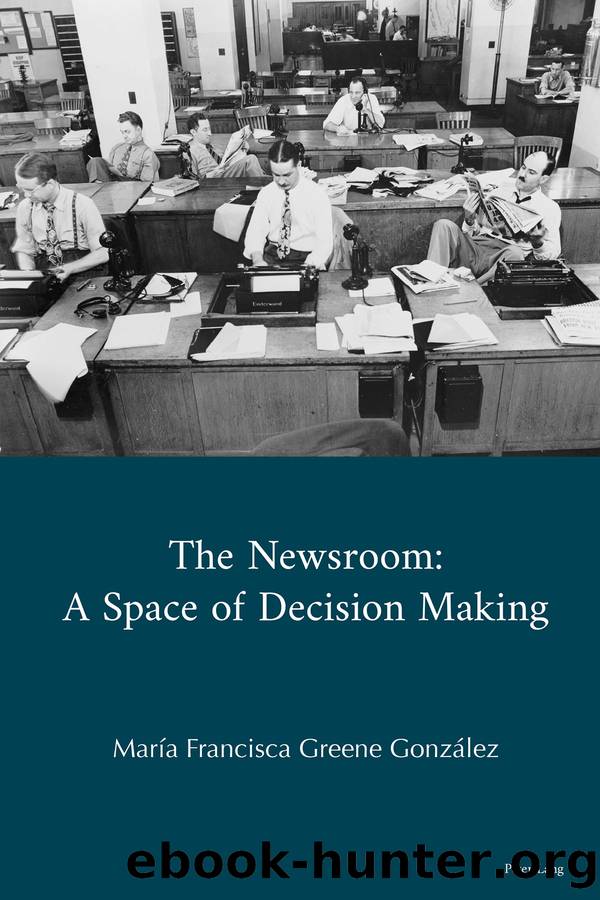The Newsroom by María Francisca Greene González

Author:María Francisca Greene González
Language: eng
Format: epub
Publisher: Peter Lang AG
The Influence of Source- or Supplier-Based Routines
Because it is impossible to be eye witnesses of all occurrences, newsworkers know reality through sources or suppliers. These sources, usually individuals, end up having an enormous influence on the content of the media. Thus, relying on sources to find out about events has become a news routine that places different guidelines, conditions and limitations on news organizations.
Based on her theory of the news network in time and space,48 Gaye Tuchman explains that when the news net is flung through space, “[it] focuses upon specific organizations, and highlight[s] topics. Of [the] … methods of dispersing reporters, geographic territoriality is most important …” In this regard she is referring to source-based routines.
To achieve a credible product, Tuchman affirms, there needs to be a mutual relationship between source and occurrence and the newsworker must question facts by going to the source. In addition, she states, viewing all sources as questionable, news reporters must spend time verifying their statements. ← 114 | 115 →
Colombo addresses the systematized routines involved in producing the news, especially in regard to sources. The problem, he explains, is that a number of interested sources can literally create a news story, not by inventing it but by making it available to the media. The cost of newswork, the required speed of its assembly and the need to have available a veritable bazaar of information “usually ensures that the media do not waste the supply”.49 Colombo’s statement is particularly important because it explains why using sources is a routine related to the nature of newswork itself. As there is limited space and time, it seems that journalists have no other alternative than to focus on readily available sources.
According to a study conducted by Sigal in 1973 and cited by Shoemaker and Reese, there are three types of source routines. Sigal defined routine channels as (1) official proceedings (trials, legislative hearings, etc.), (2) press releases, (3) press conferences, and (4) nonspontaneous events (speeches, ceremonies, etc.). Informal channels were (1) background briefings, (2) leaks, (3) nongovernmental proceedings, such as professional association meetings, and (4) reports from other news organizations, interviews with other reporters, and editorials. Enterprise channels included (1) interviews conducted at reporters’ initiative, (2) spontaneous events witnessed firsthand (fires, etc.), (3) independent research, and (4) reporters’ own conclusions and analysis. In his study, Sigal concludes that newsworkers use routine channels the most, allowing us to conclude that reporters seek out official sources in all areas most often.
A number of the authors studied express concern regarding the use of official sources and how this affects the content of the news. Peltzer says that newsworkers have used too many traditional channels, forgetting that the news is essentially for the public.
But, as Shoemaker and Reese explain, communicators depend on official sources for many different reasons. The government, or any other official source, provides a steady, convincing flow of authorized information, which ← 115 | 116 → reporters find more efficient than intensive investigation. “Reliance on sources reduces the need for expensive specialists and extensive research”.
Download
This site does not store any files on its server. We only index and link to content provided by other sites. Please contact the content providers to delete copyright contents if any and email us, we'll remove relevant links or contents immediately.
The Monuments Men by Robert M. Edsel(1485)
Things Are What You Make of Them: Life Advice for Creatives by Adam J. Kurtz(1450)
The Freelance Manifesto: A Field Guide for the Modern Motion Designer by Joey Korenman(1226)
101 Gag Ideas: Companion to the One Minute Caricature by James van der Keyl(1087)
Find Your Artistic Voice by Lisa Congdon(1058)
Boom by Michael Shnayerson(1024)
The Business of Being an Artist by Daniel Grant(973)
Your Art Will Save Your Life by Beth Pickens(949)
The Lady in Gold by Anne-marie O'connor(943)
Your Inner Critic Is a Big Jerk by Danielle Krysa(935)
Create Your Art Career by Rhonda Schaller(931)
Breakfast at Sotheby's(916)
Seven Days in the Art World by Sarah Thornton(914)
How to Survive and Prosper as an Artist by Caroll Michels(865)
33 Artists in 3 Acts by Sarah Thornton(853)
When Talent Isn't Enough: Business Basics for the Creatively Inclined by Kristen Fischer(838)
Art Held Hostage by John Anderson(827)
The Graphic Designer's Guide to Better Business Writing by Barbara Janoff & Ruth Cash-Smith(814)
Art of the Deal by Noah Horowitz(813)
